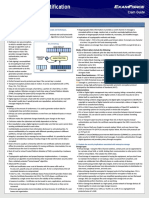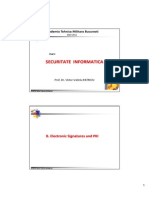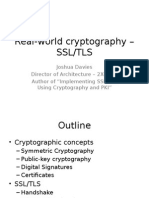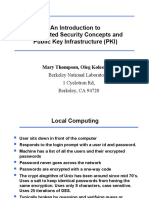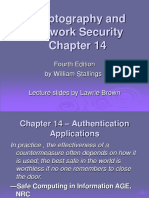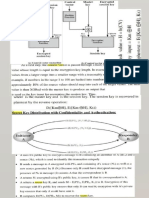0 ratings0% found this document useful (0 votes) 50 views32 pagesNew Doc Lab Python
Copyright
© © All Rights Reserved
We take content rights seriously. If you suspect this is your content,
claim it here.
Available Formats
Download as PDF or read online on Scribd
8:55 X @ bio Rey
cS)
ab
(enc ae (Z
el ue RU mol}
block cipher
An ideal block cipher is a theoretical model
of a perfect encryption system where every
plaintext block maps to a unique ciphertext
block in a random and unpredictable way,
but with a deterministic relationship
defined by the key. Despite its theoretical
strength, practical implementations of
block ciphers face several problems:
PCM CUEl uta
* Problem: Ideal block ciphers require a
unique key for each possible mapping of
plaintext to ciphertext.
* Issue: Managing, distributing, and
securely storing such a large number of
keys is impractical
2. Key Space Size
* Problem: The key space for an ideal
block cipher is extremely large (e.g., for
Ui 1a ele a EL eae EL
mappings). Vv
CRC eesti Col MC Lfe (Rll Lolo}
TW eeTer’ J ra)
(& scanned with OKEN Scanner�855 X @ GB 5c* 4 890%
= ChatGPT G
ETM Tia) ele amt LIL
mappings)
PEST -Smsle (oR Tel) cS)
computationally infeasible to represent
or process.
Paes g
Problem: Ideal block ciphers assume
Tae MAI) y Nite MCM-D e Lee g
Pele
Issue: Implementing true randomness
PIR RRL Ries MUR eof
Ryle Mules ARS ile
Deterministic Nature
Trl) me eal aD
Cierny 1M URES Ale kee elec)
SRS Tan Rel) Lk ee) (ole
[ee Tee Rec Rer in ted elite)
CRORE s
Puree ol Tlccae
Block Size Limitation
ced) y of an ideal block
Corot oMN on the block size.
Message
(& scanned with OKEN Scanner�8:55 X @ bio Rey
SMa Cat 1d
aa
5. Block Size Limitation
* Problem: The security of an ideal block
cipher relies heavily on the block size.
* Issue: Smaller block sizes can lead to
Croll Mut Xela ao
while larger block sizes increase
mmc ne Rest
Tm OM Le Lt [eo
* Problem: Real-world attackers may
ote) el atoll toed
implementation, not just theoretical
CIES
* Issue: Side-channel attacks (e.g., timing
Cae Re nt mul eumaertt
flaws can compromise security.
AICS
* Problem: Ideal block ciphers are not
scalable for systems requiring frequent
updates or dynamic encryption
fates
OSC te) el ele)
a Message J i)
(& scanned with OKEN Scanner�855 X @ Ria ES
= ChatGPT G
TC re Se oT
CIES
* Issue: Side-channel attacks (e.g., timing
or power analysis) and implementation
flaws can compromise security.
Veer Dog
* Problem: Ideal block ciphers are not
scalable for systems requiring frequent
updates or dynamic encryption
iu
* Issue: The need for massive key storage
and processing power limits scalability.
8. Randomness Assumption
* Problem: The assumption of perfect
randomness in the mapping between
plaintext and ciphertext is theoretical.
SEU oe Ne iT CRU Lo
practical systems is almost impossible.
ECR Ce ees me
Pee ea ee SRC CIC Urs LC
SEU MCE ture UCC eng
CUNT Coli elt ae em Ase T}
CeCe ACCC
Se Message
(& scanned with OKEN Scanner�Digital Signature for Authentication
Mee Re Reece ene agua ek ORO RCE uC uae NAS eli
repudiation of a digital message or document. It is akin to a handwritten signature or a stamped seal
Pee RC mR eet
Key Objectives of Digital Signatures:
BR leet RR aL elm a ee
OM rein el even ea teeta ag erate eect d eee ec sant ute
SM eas Sete eid eet eae at ik aaa eat ie Reels
Digital Signature Algorithm (DSA)
Meee RST Cr ella nee Rule ae ol ile map yoo at elas
fer eR meme Clea aioe eer me R BUC. oe Chemie cele]
Technology (NIST) in 1991.
eT eo ey
Ot Se Coals eae Ree eters
OR id em Bom cei
© scanned with OKEN Scanner�Pe elite gett
ME a Cece ce mecne Racers
pM dead
Choose a large prime number, p, and a smaller prime q such that q divides p — 1.
ee oe ee ee ae Oe Me eed oe
lee ari ae a
Calculate the public key y as:
PAR Mle
* Use a hash function (e.g., SHA-256) to hash the original message and produce a digest H(m)
EMC atid
* Choose a random number k such that 0 < k < q.
Ce lata
r=(g* mod p) mod q
Cee et og
Pei ear) mel]
4. Send the Signature and Message: oh
* Send the message m. along with the signature pair (1, 8) to the receiver.
© scanned with OKEN Scanner�OO
Advantages of DSA:
(= Mi se alte ele alta
Mite volgen lar oe
¢ Efficient key generation and verification processes.
pits te ir liit- ||) Py b
* Slower signature generation compared to RSA.
* Vulnerable if poor random numbers are used for k.
© scanned with OKEN Scanner�X.509 Certificate Format
Oe Tea eR Re ACU Rog ee MCU aa) Roki eae k)
public key to an entity (like a user, device, or organization). It provides a standard format for public key
fecal w
1. X.509 Certificate Structure
An X.509 certificate typically contains the following key fields:
Certificate Fields and Their Description
SRT
* Specifies the version of the X.509 standard (e.g, vi, v2, v3).
ee Tiss
* Aunique identifier assigned by the Certificate Authority (CA) to each certificate.
EM ey. ead ind
Oe se eee RO Ru Re elt Me eek ee age
Cd
* The name of the Certificate Authority (CA) that issued the certificate.
© scanned with OKEN Scanner�Cages
Col aR eRe od
Ode eu Meade CER emu ee CER CI
OM eV eM eee CER ee ae elem
aot ra
* The entity associated with the public key (e.g., domain name, email address, company).
7. Subject Public Key Info:
Rae ee Rae elo lee as
CM Cee AUR eRe lec
Cie) ier etal acs
* Key Usage: Specifies the intended purpose of the key (e.g., digital signature, key
encipherment).
* Subject Alternative Name (SAN): Allows multiple domains or emails.
SMP ee OR RRs ome eres Lee
Cae CMR eae Ce ew
Csr rtd
SS eerie ten ie ee carcc imate Were n oti l ora
© scanned with OKEN Scanner�3. Certificate Revocation
When an X.509 certificate is no longer valid before its expiration date (e.g., due to compromise or
misuse), it needs to be revoked by the Certificate Authority (CA).
Reasons for Revocation:
* Compromise of the private key.
Ce ieee) ae-le(cnl e Mae lene mille
Sea lel R a8
* CA improperly issued the certificate.
ee mere ella
1. Certificate Revocation List (CRL):
Ce Me Mae nea eR mene Mellel er ee ees) el shat] oe
* Clients check the CRL to verify if a certificate is revoked.
* CRs are updated periodically.�2. Online Certificate Status Protocol (OCSP):
¢ OCSP is a real-time protocol that allows clients to check a certificate’s revocation status.
se Male R ieee
* Clients query an OCSP responder, which provides the revocation status (Good, Revoked,
Unknown).
Key Differences: CRL vs OCSP
feat cRL Le) oi) 2
erie are cua Periodically updated Real-time checking
Efficiency Less efficient More efficient
Py ere Lela] ATR suid More complex
© scanned with OKEN Scanner�4. Certificate Revocation Steps:
1. The certificate holder notifies the CA about the compromise or invalidity.
2. The CA verifies the request.
MAO Eee Bin Rachie CR oR nO Mel CHa Laie coke, Gale
4. Clients check the revocation status during authentication.
Peer ire)
* \509 certificates are essential for securing communications and verifying identities in digital
Bye
* Revocation mechanisms (CRL and OCSP) ensure that compromised or invalid certificates do not
} Scanned with OKEN Scanner�Pere mull |
Arrealm generally refers to a domain, territory, or scope of authority or knowledge. Its specific
Ra kun Re ane na ett
1. In General Terms
* Arealm can mean a kingdom, domain, or region over which someone (e.g., a monarch) has
Prati
Cs eel Ree
2. In Computer Science and Networking
* In computer systems and networks, a realm refers to a logical boundary or domain used for
Peau oe
OMS ate Tn eu saa eg ee
Key Example in Networking:
* Kerberos Authentication Realm: fi
Se ee ee ae ne et Rect
© scanned with OKEN Scanner�RR ea iB B Pie)
OPEL
¢ Realm is an open-source database management system (DBMS) used primarily in mobile
and desktop applications for offline storage and data syncing.
Cs clans aie Pa Mayle) ol) eo eB es ona Ro oa mee ee) ae
Meise alata)
ee cun RRC r Mune emia eRe a cache ome lowes]
Daley
Example: “The hero journeyed to the enchanted realm to defeat the dragon.”
PPM) amar amet cy
Arealm can refer to a sphere of thought or knowledge, such as the realm of science or realm of
imagination.
Scanned with OKEN Scanner�Services Provided by PGP (Pretty Good Privacy)
PGP (Pretty Good Privacy) is a widely used encryption program designed to secure communications,
data integrity, and authentication for email and file sharing. Developed by Phil Zimmermann in 1991,
ee ee Ree Rue egy me M elie meg sree mel cede)
Catia em
pi eli a
Sree aR Mele eo Re ARR Cu R io ula
Cae ee say ke Me ROR eg RR le ME Ue Coa cic d
is encrypted using the recipient's public key.
« Example: Sensitive email content is encrypted so only the recipient with the correct private key can
eae ton
} Scanned with OKEN Scanner
You might also like
Cryptography Decrypted - Mel, H - X - , 1948 - Baker, Doris M - , 1953 - 2001 - Boston, MA - Addison-Wesley - 9780201616477 - Anna's Archive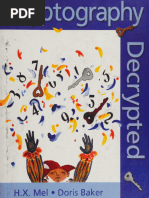
Cryptography Decrypted - Mel, H - X - , 1948 - Baker, Doris M - , 1953 - 2001 - Boston, MA - Addison-Wesley - 9780201616477 - Anna's Archive
388 pages
